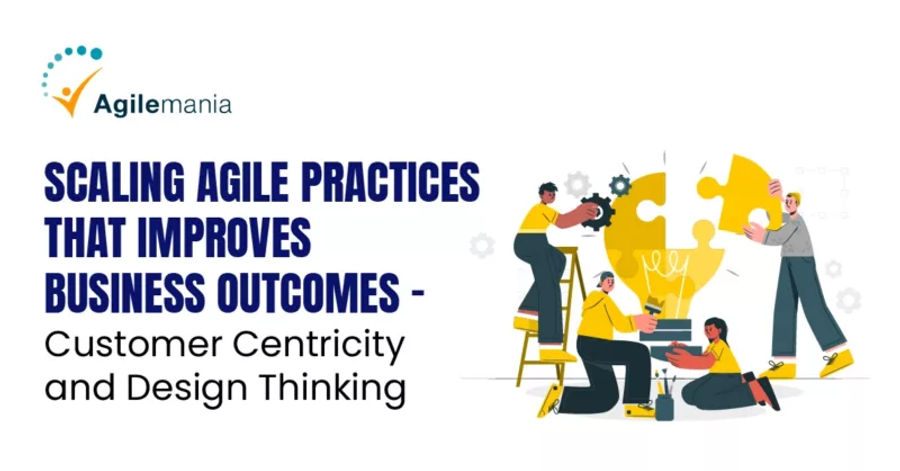
- Ashwinee Kalkura
- Nov 13th 2022
Scaled Agile Framework, SAFe® is the world's leading framework for Business Agility. SAFe® is built around seven Core Competencies with Customers as a focal point in the center. The seven core competencies each have three dimensions making it a total of twenty-one dimensions to enable Business Agility. These dimensions contain some of the practices, patterns, and guidelines to Scale Agility across the enterprise.
Customer Centricity and Design Thinking
One of the dimensions of Agile Product Delivery is Customer Centricity and Design Thinking. Customer centricity is a mindset and way of doing business that focuses on creating positive engagements as customers experience the products and services the enterprise offers. Customer-centric businesses create greater profits, increase employee engagement, and more thoroughly satisfy customer needs. Customer-centric governments and non-profits create resilience, sustainability, and the alignment needed to fulfill their mission. Lean-Agile Enterprises accomplish these goals by applying Design Thinking, an iterative solution development process that ensures solutions are desired by customers and users while also ensuring the solution is feasible, economically viable, and sustainable throughout its lifecycle.Top 5 Scaling Agile Practice that Improve Business
Customer Centricity
Customers are the ultimate beneficiaries of the value of the business solutions created and maintained by the portfolio value streams. Customer centricity is a mindset and a way of doing business that focuses on creating positive experiences for the customer through the full set of products and services that the enterprise offers. Customer centricity is a mindset: Whenever a customer-centric enterprise makes a decision, it deeply considers the effect it will have on its end users. This motivates us to:- Focus on the Customer
- Understand the Customer’s needs
- Think and feel like the Customer
- Build whole product solutions
- Know the customer lifetime value
Design Thinking
Design thinking represents a profoundly different approach to product and solution development, in which divergent and convergent techniques are applied to understand a problem, design a solution, and deliver that solution to the market. Design thinking also inspires new ways to measure the success of our efforts:- Desirable – Do customers and users want the solution?
- Feasible – Can we deliver the right solution through a combination of build, buy, partner, or acquire endeavors/activities?
- Viable – Is the way we build and offer the solution creating more value than cost? For example, in a for-profit enterprise, are we profitable?
- Sustainable – Are we proactively managing our solution to account for its expected product-market lifecycle?
Continuous Delivery Pipeline - Scaling Agile Practice
Customer Centricity Explained
- Focus on the customer – Customer-centric enterprises use segmentation to align and focus the enterprise on specific, targeted user segments.
- Understand the customer’s needs – Customer-centric enterprises move beyond merely listening to customers who ask for features. Instead, they invest the time to identify underlying and ongoing customer needs.
- Think and feel like the customer – Customer-centric enterprises try to see the world from their customer’s point of view.
- Build whole product solutions – Customer-centric enterprises design a complete solution for the user’s needs, ensuring that the initial and long-term experience of the customer is always ideal and evolving as needed.
- Know customer lifetime value – Customer-centric enterprises move beyond a transactional mentality and instead focus on creating long-term relationships based on a clear and accurate understanding of how the customer derives value from the solution.
Design Thinking Explained
The core processes of design thinking appear visually as a ‘double diamond’. This represents the focus on thoroughly exploring the problem space before creating solutions. The activities associated with exploring the problem are elaborated as follows: Discover – The discovery phase seeks to understand the problem by engaging in market and user research to identify unmet needs. The inquiries associated with the discovery phase occur without preconceived notions about how users should work. Instead, it focuses on how users do work. Define – The define phase focuses on the information gathered during the discover phase, using convergent techniques to generate insights into specific problems and/or unmet needs. With a clear understanding of the target market and the problems it’s facing, the enterprise can move towards designing a solution, the second diamond of design thinking. These are: Develop – The development phase uses journey mapping, story mapping, and prototyping to design potential solutions to problems quickly and cost-effectively. Deliver – The deliver phase produces artifacts that are suitable for creating the solution and vary based on context. They often start as prototypes. Note that each diamond focuses on divergent thinking (understanding, exploring options) followed by convergent thinking (evaluating options and making choices).Find Our Upcoming Trainings









